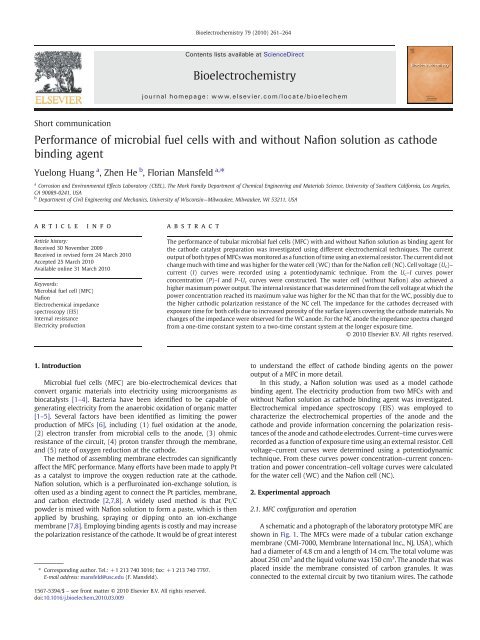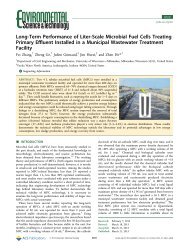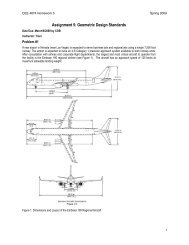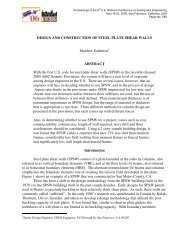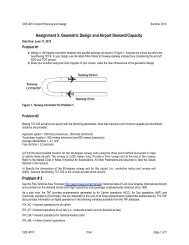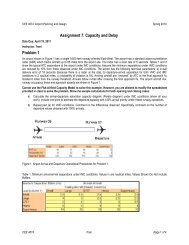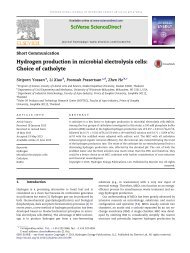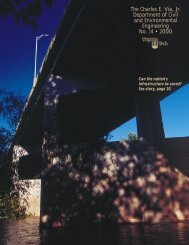Performance of microbial fuel cells with and without ... - ResearchGate
Performance of microbial fuel cells with and without ... - ResearchGate
Performance of microbial fuel cells with and without ... - ResearchGate
Create successful ePaper yourself
Turn your PDF publications into a flip-book with our unique Google optimized e-Paper software.
Bioelectrochemistry 79 (2010) 261–264Contents lists available at ScienceDirectBioelectrochemistryjournal homepage: www.elsevier.com/locate/bioelechemShort communication<strong>Performance</strong> <strong>of</strong> <strong>microbial</strong> <strong>fuel</strong> <strong>cells</strong> <strong>with</strong> <strong>and</strong> <strong>with</strong>out Nafion solution as cathodebinding agentYuelong Huang a , Zhen He b , Florian Mansfeld a, ⁎a Corrosion <strong>and</strong> Environmental Effects Laboratory (CEEL), The Mork Family Department <strong>of</strong> Chemical Engineering <strong>and</strong> Materials Science, University <strong>of</strong> Southern California, Los Angeles,CA 90089-0241, USAb Department <strong>of</strong> Civil Engineering <strong>and</strong> Mechanics, University <strong>of</strong> Wisconsin—Milwaukee, Milwaukee, WI 53211, USAarticleinfoabstractArticle history:Received 30 November 2009Received in revised form 24 March 2010Accepted 25 March 2010Available online 31 March 2010Keywords:Microbial <strong>fuel</strong> cell (MFC)NafionElectrochemical impedancespectroscopy (EIS)Internal resistanceElectricity productionThe performance <strong>of</strong> tubular <strong>microbial</strong> <strong>fuel</strong> <strong>cells</strong> (MFC) <strong>with</strong> <strong>and</strong> <strong>with</strong>out Nafion solution as binding agent forthe cathode catalyst preparation was investigated using different electrochemical techniques. The currentoutput <strong>of</strong> both types <strong>of</strong> MFCs was monitored as a function <strong>of</strong> time using an external resistor. The current did notchange much <strong>with</strong> time <strong>and</strong> was higher for the water cell (WC) than for the Nafion cell (NC). Cell voltage (U c )–current (I) curves were recorded using a potentiodynamic technique. From the U c –I curves powerconcentration (P)–I <strong>and</strong> P–U c curves were constructed. The water cell (<strong>with</strong>out Nafion) also achieved ahigher maximum power output. The internal resistance that was determined from the cell voltage at which thepower concentration reached its maximum value was higher for the NC than that for the WC, possibly due tothe higher cathodic polarization resistance <strong>of</strong> the NC cell. The impedance for the cathodes decreased <strong>with</strong>exposure time for both <strong>cells</strong> due to increased porosity <strong>of</strong> the surface layers covering the cathode materials. Nochanges <strong>of</strong> the impedance were observed for the WC anode. For the NC anode the impedance spectra changedfrom a one-time constant system to a two-time constant system at the longer exposure time.© 2010 Elsevier B.V. All rights reserved.1. IntroductionMicrobial <strong>fuel</strong> <strong>cells</strong> (MFC) are bio-electrochemical devices thatconvert organic materials into electricity using microorganisms asbiocatalysts [1–4]. Bacteria have been identified to be capable <strong>of</strong>generating electricity from the anaerobic oxidation <strong>of</strong> organic matter[1–5]. Several factors have been identified as limiting the powerproduction <strong>of</strong> MFCs [6], including (1) <strong>fuel</strong> oxidation at the anode,(2) electron transfer from <strong>microbial</strong> <strong>cells</strong> to the anode, (3) ohmicresistance <strong>of</strong> the circuit, (4) proton transfer through the membrane,<strong>and</strong> (5) rate <strong>of</strong> oxygen reduction at the cathode.The method <strong>of</strong> assembling membrane electrodes can significantlyaffect the MFC performance. Many efforts have been made to apply Ptas a catalyst to improve the oxygen reduction rate at the cathode.Nafion solution, which is a perfluroinated ion-exchange solution, is<strong>of</strong>ten used as a binding agent to connect the Pt particles, membrane,<strong>and</strong> carbon electrode [2,7,8]. A widely used method is that Pt/Cpowder is mixed <strong>with</strong> Nafion solution to form a paste, which is thenapplied by brushing, spraying or dipping onto an ion-exchangemembrane [7,8]. Employing binding agents is costly <strong>and</strong> may increasethe polarization resistance <strong>of</strong> the cathode. It would be <strong>of</strong> great interest⁎ Corresponding author. Tel.: +1 213 740 3016; fax: +1 213 740 7797.E-mail address: mansfeld@usc.edu (F. Mansfeld).to underst<strong>and</strong> the effect <strong>of</strong> cathode binding agents on the poweroutput <strong>of</strong> a MFC in more detail.In this study, a Nafion solution was used as a model cathodebinding agent. The electricity production from two MFCs <strong>with</strong> <strong>and</strong><strong>with</strong>out Nafion solution as cathode binding agent was investigated.Electrochemical impedance spectroscopy (EIS) was employed tocharacterize the electrochemical properties <strong>of</strong> the anode <strong>and</strong> thecathode <strong>and</strong> provide information concerning the polarization resistances<strong>of</strong> the anode <strong>and</strong> cathode electrodes. Current–time curves wererecorded as a function <strong>of</strong> exposure time using an external resistor. Cellvoltage–current curves were determined using a potentiodynamictechnique. From these curves power concentration–current concentration<strong>and</strong> power concentration–cell voltage curves were calculatedfor the water cell (WC) <strong>and</strong> the Nafion cell (NC).2. Experimental approach2.1. MFC configuration <strong>and</strong> operationA schematic <strong>and</strong> a photograph <strong>of</strong> the laboratory prototype MFC areshown in Fig. 1. The MFCs were made <strong>of</strong> a tubular cation exchangemembrane (CMI-7000, Membrane International Inc., NJ, USA), whichhad a diameter <strong>of</strong> 4.8 cm <strong>and</strong> a length <strong>of</strong> 14 cm. The total volume wasabout 250 cm 3 <strong>and</strong> the liquid volume was 150 cm 3 . The anode that wasplaced inside the membrane consisted <strong>of</strong> carbon granules. It wasconnected to the external circuit by two titanium wires. The cathode1567-5394/$ – see front matter © 2010 Elsevier B.V. All rights reserved.doi:10.1016/j.bioelechem.2010.03.009
262 Y. Huang et al. / Bioelectrochemistry 79 (2010) 261–264<strong>with</strong> the cathode acting as counter electrode (CE) followed by recording<strong>of</strong> the spectrum for the cathode <strong>with</strong> the anode serving as CE.3. Results <strong>and</strong> discussionFig. 1. A schematic diagram (a) <strong>and</strong> photograph <strong>of</strong> MFC (b).was a layer <strong>of</strong> a carbon/Pt mixture that was applied on the outside <strong>of</strong>the membrane. The carbon/Pt mixture was prepared by two differentmethods: 1) carbon powder containing 10% <strong>of</strong> Pt (Vulcan XC 72, BASFFuel Cell, Inc., NJ, USA) was mixed <strong>with</strong> the Nafion solution (Dupont,Nafion® perfluorinated ion-exchange resin, 1 µL for every 1 mg <strong>of</strong> Pt/Cpowder) <strong>and</strong> 2) the Nafion solution was replaced by tap water. Afterthe mixture was applied to the membrane, Ni-coated carbon fibers(TenaX®-J, Toho Tenax Co., Ltd., grade HTS 40, Irvine, CA, USA) servingas current collectors <strong>and</strong> part <strong>of</strong> the cathode were wrapped around themembrane <strong>and</strong> air-dried at room temperature overnight. An Ag/AgClreference electrode was placed in the anode chamber <strong>of</strong> each MFC.Both MFCs were fed continuously <strong>with</strong> a solution containingNaC 2 H 3 O 2·3H 2 O (3 g/L); yeast extract (0.2 g/L); NH 4 Cl (1 g/L); MgSO 4(0.25 g/L); NaCl (0.5 g/L); CaCl 2 (15 mg/L); trace solution (1 mL/L) [3]<strong>and</strong> phosphate buffered nutrient medium (100 mL/L) containingNaH 2 PO 4 (50 g/L) <strong>and</strong> Na 2 HPO 4 (107 g/L). The hydraulic retentiontime was 8 h. Twenty ml <strong>of</strong> a mixture <strong>of</strong> anaerobic <strong>and</strong> aerobic sludge(50/50), which were collected from a wastewater treatment plant(Joint Water Pollution Plant, Los Angeles, CA), was injected into theanode chamber as inoculum. All tests were conducted at roomtemperature (23 °C–25 °C).Fig. 2 shows an example <strong>of</strong> the current–time curves that wererecorded over extended time periods. The current did not changemuch <strong>with</strong> time <strong>and</strong> the WC produced higher current values than theNC. The performance <strong>of</strong> the NC <strong>and</strong> the WC was investigated by therecording U c –I curves.Since the area <strong>of</strong> the anode was not known, the experimentalcurrent <strong>and</strong> power values were normalized by the liquid volume <strong>of</strong>the anode compartment which was 150 cm 3 . Fig. 3 gives a comparison<strong>of</strong> the current concentration <strong>and</strong> the power concentration producedby the WC <strong>and</strong> the NC. Fig. 3a shows the current concentration as afunction <strong>of</strong> the cell voltage for the two <strong>cells</strong>. The maximum currentconcentration obtained from the WC (26 µA/cm 3 ) was more thantwice that from the NC (12 µA/cm 3 )(Fig. 3a). Fig. 3b shows the powerconcentration as a function <strong>of</strong> the current concentration. Themaximum power concentration produced by the WC was about1.8 µW/cm 3 compared to 1.2 µW/cm 3 for the NC. The maximumpower concentration was obtained at a cell voltage <strong>of</strong> about 200 mV inboth cases as can be seen from the P–U c curves in Fig. 3c.At the cell voltage U max where maximum power output P maxoccurs R int =R ext , where R int is the internal resistance <strong>of</strong> the MFC <strong>and</strong>R ext is the external resistor that is placed between the anode <strong>and</strong> thecathode to obtain U max [9]. R int has been defined as [9]:R int = R a p + R c p + R Ω ;where R p a <strong>and</strong> R p c are the polarization resistance <strong>of</strong> the anode <strong>and</strong> thecathode, respectively <strong>and</strong> R Ω contains the ohmic contributions such asthe solution resistance between the anode <strong>and</strong> the cathode, themembrane resistance <strong>and</strong> the electrical resistance <strong>of</strong> the electrodes,leads, etc. R int <strong>of</strong> the WC was calculated as 117 Ω, while for the NC avalue <strong>of</strong> 195 Ω was obtained. As discussed previously, R int depends oncell voltage [9].The impedance spectra obtained for the NC <strong>and</strong> the WC at theopen-circuit potential (OCP) for the cathode <strong>and</strong> the anode during theexposure times <strong>of</strong> 120 <strong>and</strong> 140 days are shown in Fig. 4 as Bode-plotsin which the logarithm <strong>of</strong> the impedance modulus |Z| is plotted vs. thelogarithm <strong>of</strong> the applied frequency f. The impedance spectra <strong>of</strong> the NC<strong>and</strong> the WC cell cathodes are in general agreement <strong>with</strong> the coatingmodel proposed by Mansfeld et al. [10,11] for the analysis <strong>of</strong>impedance data for polymer coated metals. The decrease <strong>of</strong> theimpedance <strong>of</strong> the cathode for both MFCs <strong>with</strong> the exposure time isconsidered to be due to a decrease <strong>of</strong> the thickness <strong>of</strong> the polymerð1Þ2.2. Data collectionThe voltage across a R ext =500Ω external resistor was recordedevery 30 s using a computer based data acquisition system (Keithley2700 multimeter). These measurements were only interrupted whenimpedance spectra or cell voltage–current curves were recorded. Cellvoltage (U c )–current (I) curves were collected by applying a potentiodynamicscan at a scan rate <strong>of</strong> 0.1 mV/s from the open-circuit cellvoltage U oc to zero cell voltage U o using a Gamry reference 600potentiostat. The power concentration P (µW/cm 3 ) based on the liquidvolume <strong>of</strong> the MFC was calculated from the U c –I curves <strong>and</strong> plotted as afunction <strong>of</strong> current concentration (j) or cell voltage. The impedancespectra were collected at the open-circuit potential (OCP) <strong>of</strong> the anode<strong>and</strong> the cathode using a Gamry reference 600 potentiostat (Garmryinstruments, Warminster, PA, USA). An ac voltage signal <strong>of</strong> 10 mV wasapplied in a frequency range from 100 kHz to 5 mHz. EIS measurementswere conducted by first recording the impedance spectrum <strong>of</strong> the anodeFig. 2. Current–time curves for the WC <strong>and</strong> the NC (R ext =500 Ω) for an exposure time<strong>of</strong> 34 days.
Y. Huang et al. / Bioelectrochemistry 79 (2010) 261–264263Fig. 4. Bode-plots for the cathode (a) <strong>and</strong> the anode (b) <strong>of</strong> the WC <strong>and</strong> the NC for anexposure time <strong>of</strong> 65 days.explained at present, however they point to a complex interactionbetween the anode <strong>and</strong> the cathode for the NC.4. Summary <strong>and</strong> conclusionsFig. 3. Cell voltage–current concentration (a), power concentration–current concentration(b) <strong>and</strong> power concentration–cell voltage curves (c) for the WC <strong>and</strong> the NC foran exposure time <strong>of</strong> 55 days.layers covering the graphite fibers (increase <strong>of</strong> high-frequencycapacitance) <strong>and</strong> increased porosity <strong>of</strong> these layers (decrease <strong>of</strong>pore resistance at intermediate frequencies) (Fig. 4b). The impedance<strong>of</strong> the cathode for the NC is higher than that for the WC for bothexposure times due to the polymer layers formed during treatment<strong>with</strong> the Nafion solution.The impedance spectra for the WC anode did not changesignificantly <strong>with</strong> time indicating stable behavior (Fig. 4a). Theimpedance for fb10 4 Hz is due to the solution resistance <strong>and</strong> is verylow. The impedance for fb1 Hz is due to the capacitance <strong>of</strong> the anode.The impedance spectra for the NC anode at 120 days were differentfrom those <strong>of</strong> the WC at the same exposure time <strong>with</strong> a significantlylower capacitance value. The spectra changed to a two-time constantsystem for an exposure time <strong>of</strong> 140 days. These changes cannot beThe performance <strong>of</strong> tubular MFCs (Fig. 1) <strong>with</strong> <strong>and</strong> <strong>with</strong>out Nafionsolution as a binding agent was investigated using different electrochemicaltechniques. The current–time curves (Fig. 2) <strong>and</strong>thepowerconcentration–current concentration or power concentration–cellvoltage curves that were obtained from the experimental cell voltage–current curves (Fig. 3) have demonstrated that the power production bythe water cell is higher than that <strong>of</strong> the Nafion cell. The internalresistance determined from the power density–cell voltage curves(Fig. 3c) was higher for the Nafion cell. The impedance spectra for thecathodes <strong>of</strong> the two MFCs suggest that this higher value is due to thehigher polarization resistance <strong>of</strong> the Nafion cell cathode. The ohmiccontribution to the internal resistance (Eq. (1)) was very small (Fig. 4).The Nafion polymer layers covering the cathode material (Pt particles<strong>and</strong> Ni-coated carbon fibers) apparently block access <strong>of</strong> oxygen <strong>and</strong>thereby reduce the rate <strong>of</strong> oxygen reduction.AcknowledgmentThe authors acknowledge financial support from the ChevronCorporation.
264 Y. Huang et al. / Bioelectrochemistry 79 (2010) 261–264References[1] B. Logan, B. Hamelers, R. Rozendal, U. Schroder, J. Keller, S. Freguia, P. Aelterman,W. Verstraete, K. Rabaey, Microbial <strong>fuel</strong> <strong>cells</strong>: methodology <strong>and</strong> technology,Environ. Sci. Technol. 40 (17) (2006) 5181–5192.[2] K. Rabaey, J. Rodríguez, L.L. Blackall, J. Keller, P. Gross, D. Batstone, W. Verstraete,K.H. Nealson, Microbial ecology meets electrochemistry: electricity-driven <strong>and</strong>driving communities, ISME J. 1 (2007) 9–18.[3] Z. He, N. Wagner, S.D. Minteer, L.T. Angenent, An upflow <strong>microbial</strong> <strong>fuel</strong> cell <strong>with</strong> aninterior cathode: assessment <strong>of</strong> the internal resistance by impedance spectroscopy,Environ. Sci. Technol. 40 (2006) 5212–5217.[4] A.K. Shukla, P. Suresh, S. Berchmans, A. Rajendran, Biological <strong>fuel</strong> <strong>cells</strong> <strong>and</strong> theirapplications, Curr. Sci. 87 (4) (2004) 455–468.[5] R.M. Allen, H.P. Bennetto, Microbial <strong>fuel</strong>-<strong>cells</strong>: electricity production fromcarbohydrates, Appl. Biochem. Biotechnol. 39/40 (1993) 27–40.[6] G.C. Gil, I.S. Chang, B.H. Kim, M. Kim, J.K. Jang, H.S. Park, H.J. Kim, Operationalparameters affecting the performance <strong>of</strong> a mediator-less <strong>microbial</strong> <strong>fuel</strong> cell,Biosens. Bioelectron. 18 (2003) 327–334.[7] J.R. Kim, G.C. Premier, F.R. Hawkes, R.M. Dinsdals, A.J. Guwy, Development <strong>of</strong> atubular <strong>microbial</strong> <strong>fuel</strong> cell (MFC) employing a membrane electrode assemblycathode, J. Power Sources 187 (2009) 393–399.[8] S. Cheng, H. Liu, B.E. Logan, Increased performance <strong>of</strong> single-chamber <strong>microbial</strong> <strong>fuel</strong><strong>cells</strong> using an improved cathode structure, Electrochem. Commun. 8 (2006) 489–494.[9] A.K. Manohar, O. Bretschger, K.H. Nealson, F. Mansfeld, The use <strong>of</strong> electrochemicalimpedance spectroscopy (EIS) in the evaluation <strong>of</strong> the electrochemical properties<strong>of</strong> a <strong>microbial</strong> <strong>fuel</strong> cell, Bioelectrochemistry 72 (2008) 149–154.[10] F. Mansfeld, Use <strong>of</strong> electrochemical impedance spectroscopy for the study <strong>of</strong>corrosion protection by polymer coatings, J Appl. Electrochem. 25 (1995) 187–202.[11] F. Mansfeld, L.T. Han, C.C. Lee, G. Zhang, Evaluation <strong>of</strong> corrosion protection bypolymer coatings <strong>with</strong> electrochemical impedance spectroscopy <strong>and</strong> noiseanalysis, Electrochim. Acta 43 (1998) 2933–2945.


